“Fingerprinting” Benign and Cancerous Skin Lesions Using Vibrational Optical Coherence Tomography: Differentiation among Cancerous Lesion Types Based on the Presence of New Cells, Blood Vessels, and Fibrosis
Abstract
1. Introduction
2. Materials and Methods
2.1. Subjects
2.2. OCT Images and Scans of Pixel Intensity Versus Depth
2.3. Measurement of Resonant Frequency and the Elastic Modulus
3. Results
4. Discussion
4.1. Fingerprinting Skin Cancers
4.1.1. Is Fibrotic Tissue Deposition a Sign of Skin Cancer?
4.1.2. Invasiveness of Skin Lesions
5. Conclusions
Author Contributions
Funding
Institutional Review Board Statement
Informed Consent Statement
Data Availability Statement
Conflicts of Interest
References
- Cox, T.R.; Erler, J.T. Molecular pathways: Connecting fibrosis and solid tumor metastasis. Clin. Cancer Res. 2014, 20, 3637–3643. [Google Scholar] [CrossRef] [PubMed]
- Brücher, B.L.; Jamall, I.S. Epistemology of the origin of cancer: A new paradigm. BMC Cancer 2014, 14, 331. [Google Scholar] [CrossRef] [PubMed]
- Mishra, D.K.; Compean, S.D.; Thrall, M.J.; Liu, X.; Massarelli, E.; Kurie, J.M.; Kim, M.P. Human Lung Fibroblasts Inhibit Non-Small Cell Lung Cancer Metastasis in Ex Vivo 4D Model. Ann. Thorac. Surg. 2015, 100, 1167–1174. [Google Scholar] [CrossRef] [PubMed]
- Yamauchi, M.; Barker, T.H.; Gibbons, D.L.; Jonathan, M.K. The fibrotic tumor stroma. J. Clin. Investig. 2018, 128, 16–25. [Google Scholar] [CrossRef] [PubMed]
- Erdogan, B.; Webb, D.J. Cancer-associated fibroblasts modulate growth factor signaling and extracellular matrix remodeling to regulate tumor metastasis. Biochem. Soc. Trans. 2017, 45, 229–236. [Google Scholar] [CrossRef]
- Cox, T.R.; Bird, D.; Baker, A.-E.; Barker, H.E.; Ho, M.W.-Y.; Lang, G.; Erler, J.T. LOX-mediated collagen crosslinking is responsible for fibrosis-enhanced metastasis. Cancer Res. 2013, 73, 1721–1732. [Google Scholar] [CrossRef]
- Park, J.S.; Lee, J.H.; Lee, Y.S.; Kim, J.K.; Dong, S.M.; Yoon, D.S. Emerging role of LOXL2 in the promotion of pancreas cancer metastasis. Oncotarget 2016, 7, 42539–42552. [Google Scholar] [CrossRef]
- Margadant, C.; Sonnenberg, A. Integrin–TGF-β crosstalk in fibrosis, cancer and wound healing. EMBO Rep. 2010, 11, 97–105. [Google Scholar] [CrossRef]
- Wang, K.; Andresen Eguiluz, R.C.; Wu, F.; Seo, B.R.; Fischbach, C.; Gourdon, D. Stiffening and unfolding of early deposited-fibronectin increase proangiogenic factor secretion by breast cancer-associated stromal cells. Biomaterials 2015, 54, 63–71. [Google Scholar] [CrossRef]
- Stenman, S.; Vaheri, A. Fibronectin in human solid tumors. Int. J. Cancer 1981, 27, 427–435. [Google Scholar] [CrossRef]
- Chandler, E.M.; Saunders, M.P.; Yoon, C.J.; Gourdon, D.; Fischbach, C. Adipose progenitor cells increase fibronectin matrix strain and unfolding in breast tumors. Phys. Biol. 2011, 8, 015008. [Google Scholar] [CrossRef] [PubMed]
- Barkan, D.; El Touny, L.H.; Michalowski, A.M.; Smith, J.A.; Chu, I.; Davis, A.S.; Webster, J.D.; Hoover, S.; Simpson, R.M.; Gauldie, J.; et al. Metastatic growth from dormant cells induced by a col-I-enriched fibrotic environment. Cancer Res. 2010, 70, 5706–5716. [Google Scholar] [CrossRef] [PubMed]
- Samani, A.; Zubovits, J.; Plewes, D. Elastic moduli of normal and pathological humanbreast tissues: An inversion-technique-based investigation of 169 samples. Phys. Med. Biol. 2007, 52, 1565–1576. [Google Scholar] [CrossRef]
- Acerbi, I.; Cassereau, L.; Dean, I.; Shi, Q.; Au, A.; Park, C.; Chen, Y.Y.; Liphardt, J.; Hwang, E.S.; Weaver, V.M. Human breast cancer invasion and aggression correlates with ECM stiffening and immune cell infiltration. Integr. Biol. 2016, 7, 1120–1134. [Google Scholar] [CrossRef] [PubMed]
- Lin, H.-H.; Lin, H.-K.; Lin, I.-H.; Chiou, Y.-W.; Chen, H.-W.; Liu, C.-Y.; Harn, H.I.-C.; Chiu, W.-T.; Wang, Y.-K.; Shen, M.-R.; et al. Mechanical phenotype of cancer cells: Cell softening and loss of stiffness sensing. Oncotarget 2015, 6, 20946–20958. [Google Scholar] [CrossRef] [PubMed]
- Lekka, M. Discrimination between normal and cancerous cells using AFM. Bionanoscience 2016, 6, 65–80. [Google Scholar] [CrossRef]
- Silver, F.H.; Deshmukh, T.; Benedetto, D.; Kelkar, N. Mechano-vibrational spectroscopy of skin: Are changes in collagen and vascular tissue components early signs of basal cell carcinoma formation? Skin. Res. Technol. 2020, 27, 227–233. [Google Scholar] [CrossRef]
- Silver, F.H.; Kelkar, N.; Deshmukh, T.; Ritter, N.; Ryan, N.; Nadiminiti, H. Characterization of the biomechanical properties of skin using vibrational optical coherence tomography: Do changes in the biomechanical properties of skin stroma reflect structural changes in the extracellular matrix of cancerous lesions? Biomolecules 2021, 11, 1712. [Google Scholar] [CrossRef]
- Silver, F.H.; Deshmukh, T.; Kelkar, N.; Ritter, N.; Ryan, N.; Nadiminti, H. The “Virtual Biopsy” of Cancerous Lesions in 3D: Non-Invasive Differentiation between Melanoma and Other Lesions Using Vibrational Optical Coherence Tomography. Dermatopathology 2021, 8, 539–551. [Google Scholar] [CrossRef]
- Silver, F.H.; Shah, R.G.; Richard, M.; Benedetto, D. Comparative “virtual biopsies” of normal skin and skin lesions using vibrational optical coherence tomography. Skin. Res. Technol. 2019, 25, 743–749. [Google Scholar] [CrossRef]
- Silver, F.H.; Shah, R.G.; Richard, M.; Benedetto, D. Use of Vibrational Optical Coherence Tomography to Image and Characterize a Squamous Cell Carcinoma. J. Dermatology Res. Ther. 2019, 5, 067. [Google Scholar] [CrossRef]
- Silver, F.H.; Shah, R. Measurement of Mechanical Properties of Natural and Engineered Implants. Adv. Tissue Eng. Regen. Med. Open Access 2016, 1, 20–25. [Google Scholar] [CrossRef]
- Shah, R.G.; Devore, D.; Pierce, M.C.; Silver, F.H. Vibrational analysis of implants and tissues: Calibration and mechanical spectroscopy of multi-component materials. J. Biomed. Mater. Res.—Part A 2017, 105, 1666–1671. [Google Scholar] [CrossRef]
- Silver, F.H.; Kelkar, N.; Desmukh, T.; Horvath, I.; Shah, R.G. Mechano-Vibrational Spectroscopy of Tissues and Materials Using Vibrational Optical Coherence Tomography: A New Non-Invasive and Non-Destructive Technique. Recent Prog. Mater. 2020, 2, 1. [Google Scholar] [CrossRef]
- Runyan, R.B.; Savagner, P. Epithelial–Mesenchymal Transition and Plasticity in the Developmental Basis of Cancer and Fibrosis. Dev. Dyn. 2018, 247, 330–331. [Google Scholar] [CrossRef] [PubMed]
- Miguel, J.; Lopez-Novoa, J.M.; Nieto, M.A. Inflammation and EMT: An alliance towards organ fibrosis and cancer progression. EMBO Mol. Med. 2009, 1, 303–314. [Google Scholar]
- Xing, F.; Saidou, J.; Watabe, K. Cancer associated fibroblasts (CAFs) in tumor microenvironment. Front Biosci. 2010, 15, 166–179. [Google Scholar] [CrossRef]
- Miles, F.L.; Sikes, R.A. Insidious Changes in Stromal Matrix Fuel Cancer Progression. Mol. Cancer Res. 2014, 12, 297–312. [Google Scholar] [CrossRef]
- Yu, Y.; Xiao, C.H.; Tan, L.D.; Wang, Q.S.; Li, X.Q.; Feng, Y.M. Cancer-associated fibroblasts induce epithelial–mesenchymal transition of breast cancer cells through paracrine TGF-β signalling. Br. J. Cancer 2014, 110, 724–773. [Google Scholar] [CrossRef]
- Ao, M.; Franco, O.E.; Park, D.; Raman, D.; Williams, K.; Hayward, S.W. Cross-talk between Paracrine-Acting Cytokine and Chemokine Pathways Promotes Malignancy in Benign Human Prostatic Epithelium. Cancer Res. 2007, 67, 4244–4253. [Google Scholar] [CrossRef]
- Kalluri, R.; Weinberg, R.A. The basics of epithelial-mesenchymal transition. J. Clin. Investig. 2009, 119, 1420–1428. [Google Scholar] [CrossRef] [PubMed]
- Levental, K.R.; Yu, H.; Kass, L.; Lakins, J.N.; Egeblad, M.; Erler, J.T.; Fong, S.F.T.; Csiszar, K.; Giaccia, A.; Weninger, W.; et al. Matrix crosslinking forces tumor progression by enhancing integrin signaling. Cell 2009, 139, 891–906. [Google Scholar] [CrossRef] [PubMed]
- Provenzano, P.P.; Inman, D.R.; Eliceiri, K.W.; Knittel, J.G.; Yan, L.; Rueden, C.T.; White, J.G.; Keely, P.J. Collagen density promotes mammary tumor initiation and progression. BMC Med. 2008, 6, 11. [Google Scholar] [CrossRef]
- Bai, Y.; Bai, Y.; Dong, J.; Li, Q.; Jin, Y.; Chen, B.; Zhou, M. Hedgehog Signaling in Pancreatic Fibrosis and Cancer. Medicine 2016, 95, e2996. [Google Scholar] [CrossRef] [PubMed]
- Dey, A.; Varelas, X.; Guan, K.-L. Targeting the Hippo pathway in cancer, fibrosis, wound healing and regenerative medicine. Nat. Rev. Drug Discov. 2020, 19, 480–494. [Google Scholar] [CrossRef] [PubMed]
- Hsu, T.; Nguyen-Tran, H.-H.; Trojanowska, M. Active roles of dysfunctional vascular endothelium in fibrosis and cancer. J. Biomed. Sci. 2019, 26, 86. [Google Scholar] [CrossRef]
- Doillon, C.J.; Dunn, M.G.; Bender, E.; Silver, F.H. Collagen Fiber Formation In Vivo: Development of Wound Strength and Toughness. Collagen Relat. Res. 1985, 5, 481–492. [Google Scholar] [CrossRef]
- Goldstein, J.D.; Tria, A.J.; Zawadsky, J.P.; Kato, Y.P.; Christiansen, D.; Silver, F.H. Development of a Reconstituted Collagen Tendon Prosthesis. J. Bone Jt. Surg. 1989, 71A, 1183–1191. [Google Scholar] [CrossRef]
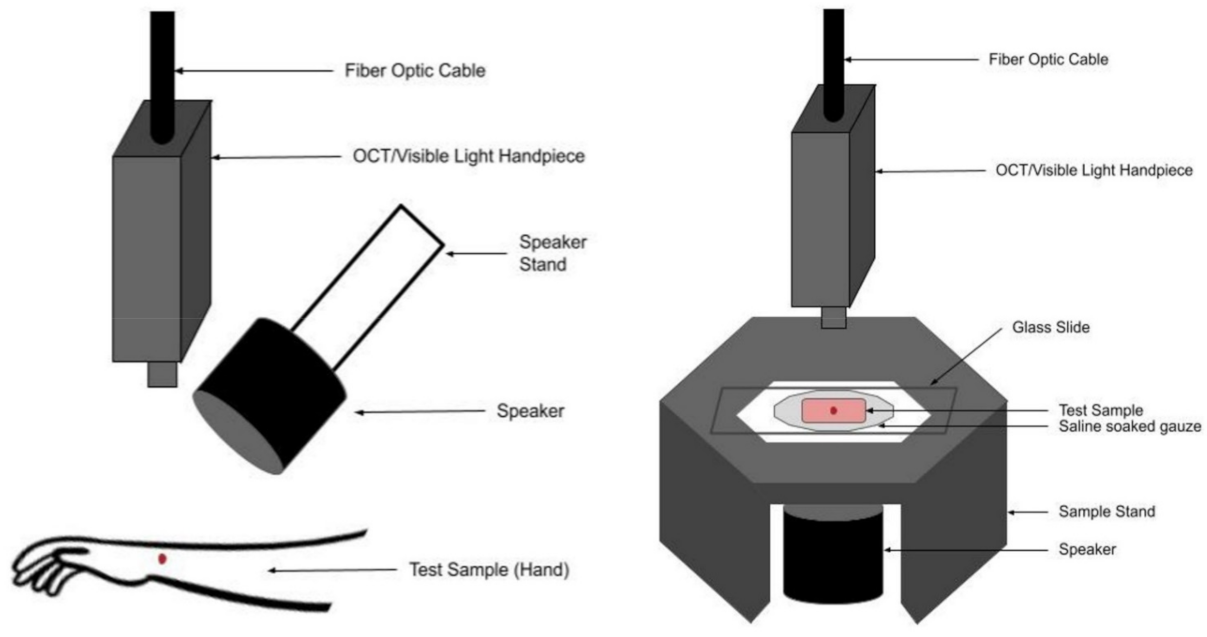
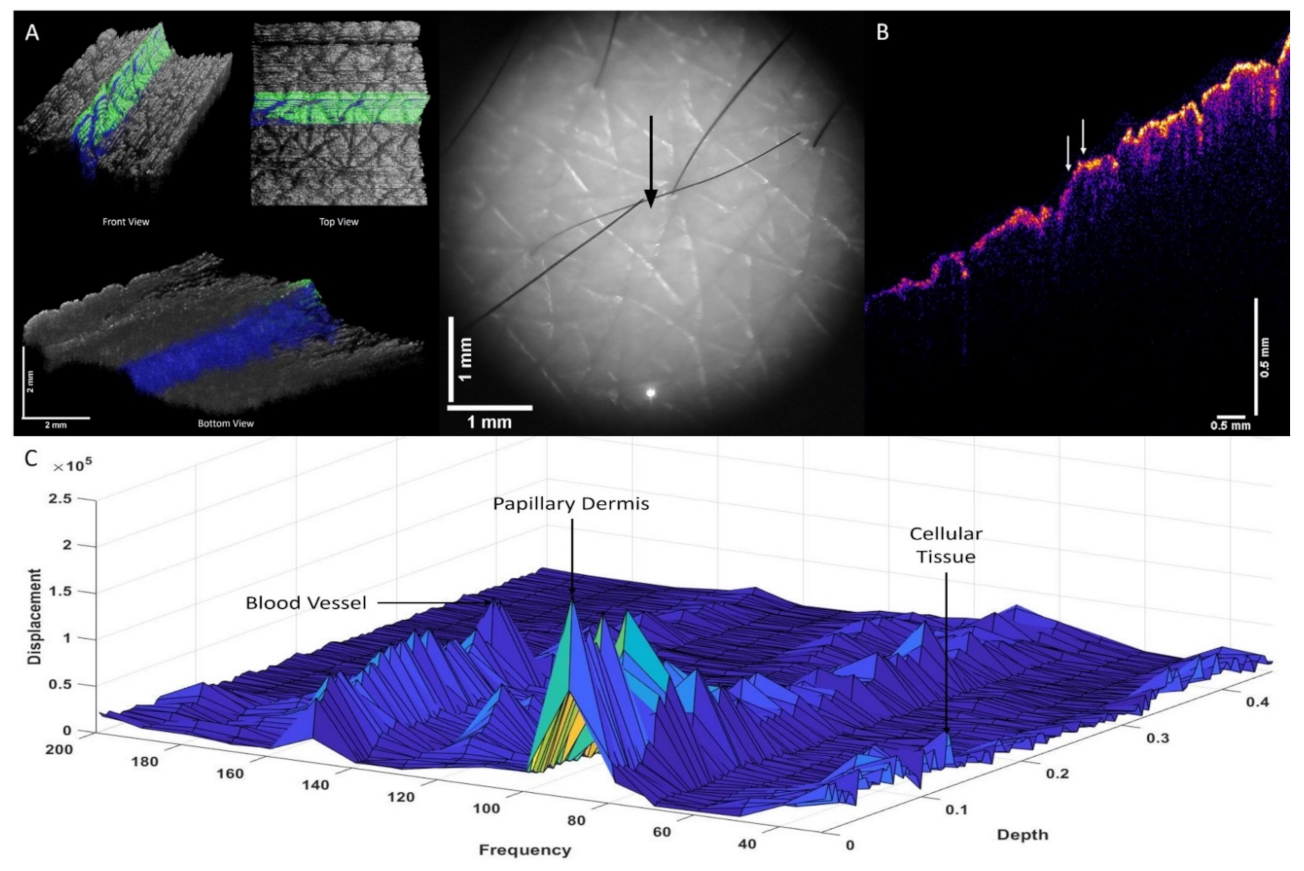


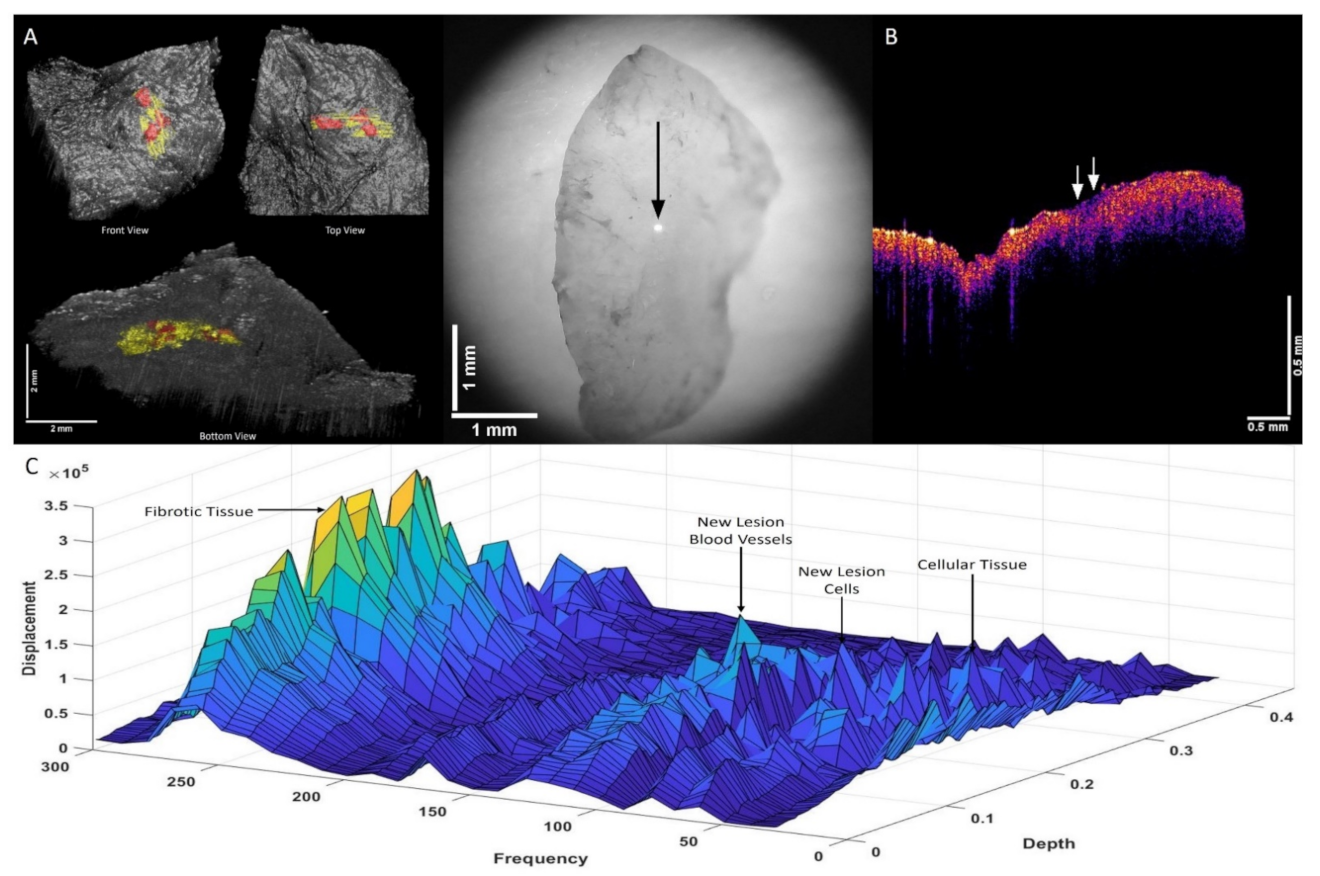
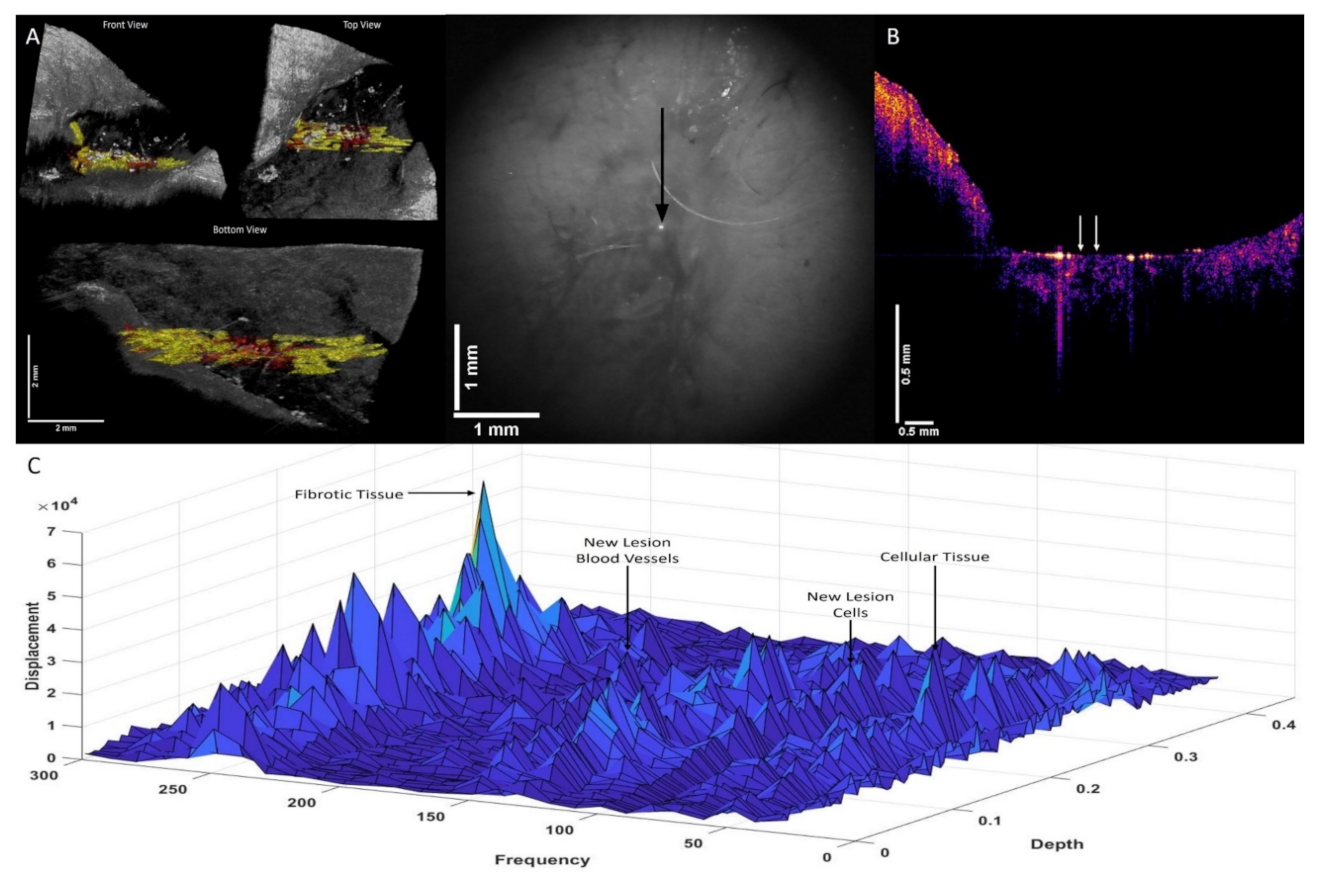

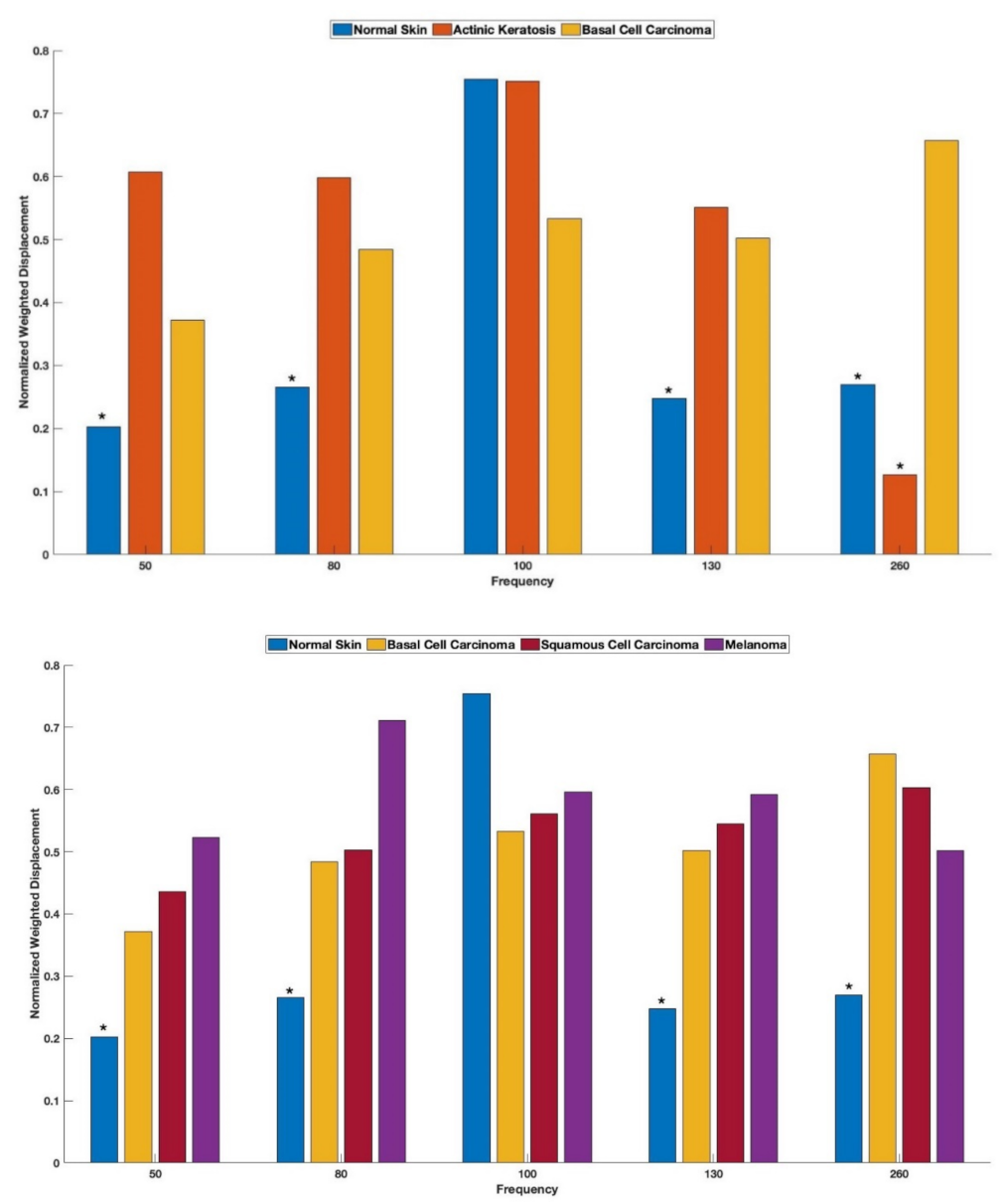
| Resonant Frequency | ||||||
|---|---|---|---|---|---|---|
| Sample | No. of Measurements | 50 Hz | 80 Hz | 100 Hz | 130 Hz | 260 Hz |
| Normal Skin | 14 | 50 {0} | NA | 100 {0} | NA | NA |
| AK | 7 | 50 {0} | 75.71 {7.68} | 104.28 {5.34} | 127.14 {4.81} | NA |
| Nodular BCC | 27 | 52.77 {4.60} | 75.55 {5.06} | 102.22 {4.23} | 125.18 {5.09} | 262.59 {4.46} |
| Superficial BCC | 6 | 54 {5.47} | 80 {0} | 102 {4.47} | 126.67 {5.16} | 261.67 {4.08} |
| SCC | 46 | 49.56 {2.06} | 75.86 {4.97} | 104.78 {5.05} | 127.82 {4.17} | 262.82 {4.55} |
| Melanoma | 57 | 50 {0} | 76.31 {4.86} | 102.20 {4.18} | 128.24 {3.83} | 262.98 {4.61} |
| All values in table are in Hz | ||||||
| Modulus | ||||||
| Sample | No. of Measurements | 50 Hz | 80 Hz | 100 Hz | 130 Hz | 260 Hz |
| Normal Skin | 14 | 1.231 {0.140} | NA | 2.66 {0.32} | NA | NA |
| AK | 7 | 0.88 {0.160} | 1.60 {0.24} | 2.54 {0.81} | 4.52 {1.206} | NA |
| Nodular BCC | 27 | 1.467 {0.26} | 2.31 {0.41} | 3.20 {0.46} | 4.41 {0.78} | 16.51 {2.65} |
| Superficial BCC | 6 | 1.525 {0.74} | 2.27 {0.40} | 2.86 {1.207} | 4.46 {0.69} | 16.38 {2.82} |
| SCC | 46 | 1.304 {0.156} | 2.02 {0.28} | 3.15 {0.45} | 4.30 {0.47} | 15.68 {1.826} |
| Melanoma | 57 | 1.459 {0.162} | 2.26 {0.29} | 3.36 {0.41} | 4.81 {0.56} | 17.44 {1.938} |
| All values in table are in MPa | ||||||
| 50 Hz/80 Hz Displacement Ratios | ||
|---|---|---|
| SCC | Melanoma | |
| BCC | 0.038 | 0.37 |
| Melanoma | 0.031 | |
| Values in red show statistical significance | ||
| 130 Hz/80 Hz Displacement Ratios | ||
| SCC | Melanoma | |
| BCC | 0.4 | 0.045 |
| Melanoma | 0.006 | |
| Values in red show statistical significance | ||
Publisher’s Note: MDPI stays neutral with regard to jurisdictional claims in published maps and institutional affiliations. |
© 2022 by the authors. Licensee MDPI, Basel, Switzerland. This article is an open access article distributed under the terms and conditions of the Creative Commons Attribution (CC BY) license (https://creativecommons.org/licenses/by/4.0/).
Share and Cite
Silver, F.H.; Deshmukh, T.; Ryan, N.; Romm, A.; Nadiminti, H. “Fingerprinting” Benign and Cancerous Skin Lesions Using Vibrational Optical Coherence Tomography: Differentiation among Cancerous Lesion Types Based on the Presence of New Cells, Blood Vessels, and Fibrosis. Biomolecules 2022, 12, 1332. https://doi.org/10.3390/biom12101332
Silver FH, Deshmukh T, Ryan N, Romm A, Nadiminti H. “Fingerprinting” Benign and Cancerous Skin Lesions Using Vibrational Optical Coherence Tomography: Differentiation among Cancerous Lesion Types Based on the Presence of New Cells, Blood Vessels, and Fibrosis. Biomolecules. 2022; 12(10):1332. https://doi.org/10.3390/biom12101332
Chicago/Turabian StyleSilver, Frederick H., Tanmay Deshmukh, Nicole Ryan, Arielle Romm, and Hari Nadiminti. 2022. "“Fingerprinting” Benign and Cancerous Skin Lesions Using Vibrational Optical Coherence Tomography: Differentiation among Cancerous Lesion Types Based on the Presence of New Cells, Blood Vessels, and Fibrosis" Biomolecules 12, no. 10: 1332. https://doi.org/10.3390/biom12101332
APA StyleSilver, F. H., Deshmukh, T., Ryan, N., Romm, A., & Nadiminti, H. (2022). “Fingerprinting” Benign and Cancerous Skin Lesions Using Vibrational Optical Coherence Tomography: Differentiation among Cancerous Lesion Types Based on the Presence of New Cells, Blood Vessels, and Fibrosis. Biomolecules, 12(10), 1332. https://doi.org/10.3390/biom12101332






